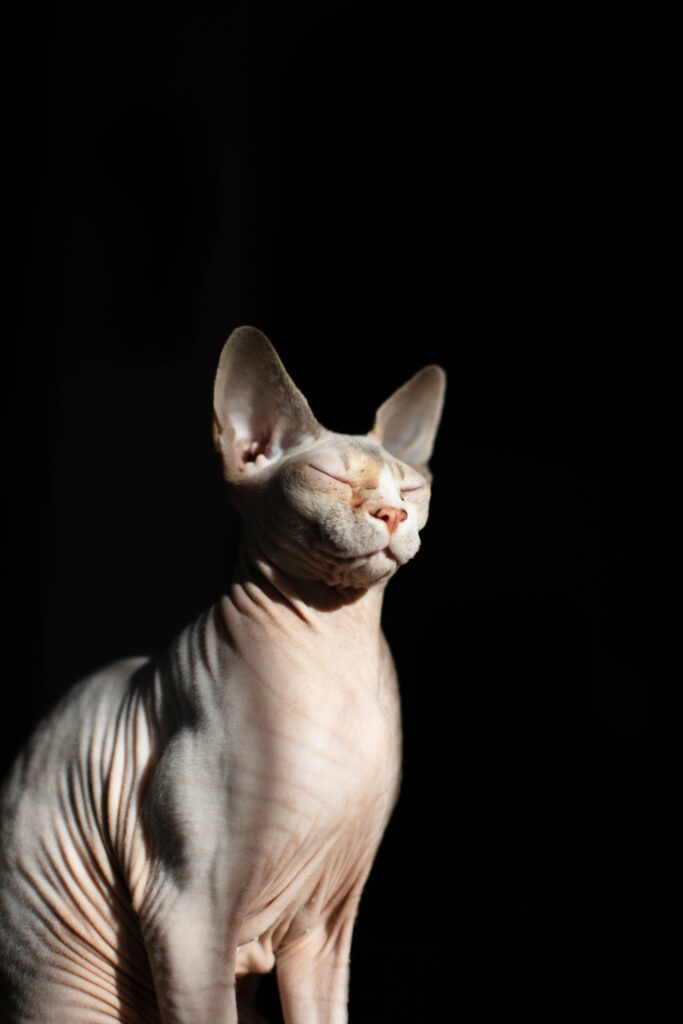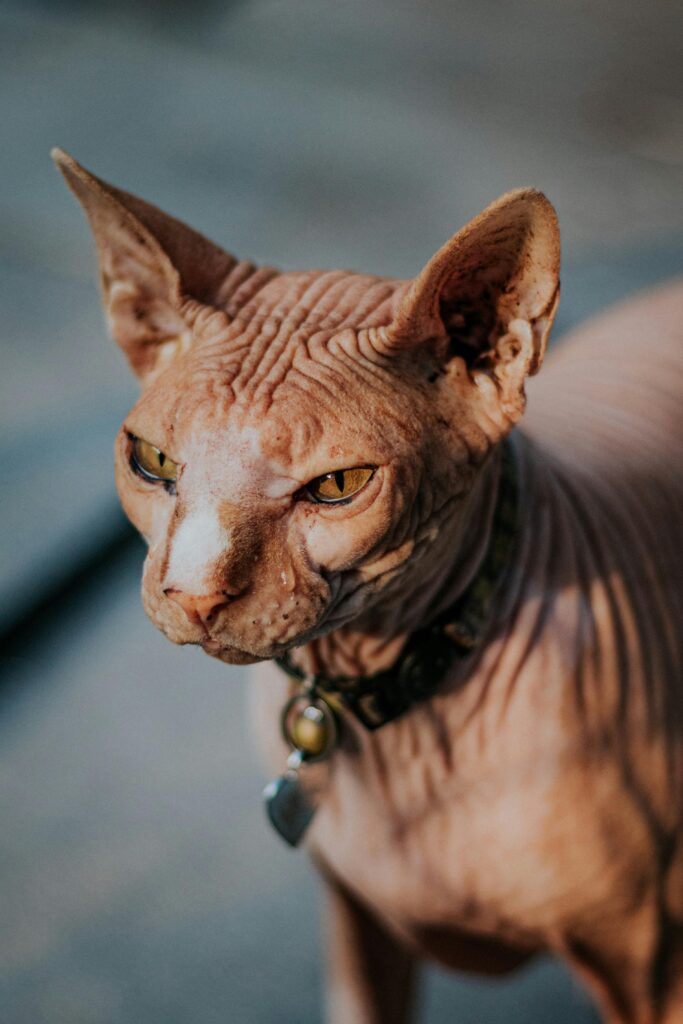

Sphynx and Donskoy breeds look similar but they are not related. Different mutations cause these cats’ hairlessness.
Donskoys are heavier and have more variation in how much fur they can have. Some are bald, others have spotty or diffuse coats as young cats or their entire lives, while Sphynxes are either bald or covered with fuzz uniformly. Sphynx and Donskoy cats are smart, easy to train, and friendly with other pets. Neither breed is hypoallergenic, although Sphynx cats are known to produce little FelD1 protein, so they are less likely to cause allergies.
Basic Parameters
| Donskoy (also known as Don Sphynx) | Sphynx | |
| Weight | 6-15 lb (2.5-7 kg) | under 12 lb (5.5 kg) |
| Height | 13-15 in (33-38 cm) | 13-15 in (33-38 cm) |
| Lifespan | up to 15 years | up to 14 years |
| Coat | bald to light fuzz | can have some peach fuzz |
| Color | any colors that happen in cats | any colors that typical for cats |
| Personality | friendly, playful, intelligent | friendly, playful, intelligent |
| Hypoallergenic | no | no |
Are Sphynx and Donskoy Cats Related?
Donskoy and Sphynx cats are not related. Different mutations cause their baldness:
- A recessive mutation causes hairlessness in Sphynxes
- A dominant mutation is responsible for the feature of hairlessness in Donskoy cats
THE MAIN DIFFERENCES BETWEEN SPHYNXES AND DONSKOYS
– Mutation type
As mentioned in the section above, different mutations cause baldness feature in the two breeds, which has implications for these animals.
A dominant mutation causes hairlessness in Donskoys, which means all kittens are hairless if at least one parent is a Donskoy.
As a result of the dominant mutation, Donskoys can be impacted by feline ectodermal dysplasia, a complex and serious condition we will discuss further in the Health Problems section.
Sphynxes do not always pass on baldness to their kittens if only one parent is a Sphynx. It is also uncommon for them to suffer from feline ectodermal dysplasia.
– Baldness/Fur Type
- Sphyxes are either completely bald or have diffuse, velvety fuzz all over their bodies.
- Donskoys can come with a variety of coat patterns or lack thereof. Their fur can be present young and disappear after a few months. Their coat can also be partial or complete and have a more diverse texture – from velvety to brushy.
– Availability of the Breed
Sphynx cats are a well-established breed. Although they are still quite expensive to purchase and maintain, generally, it is not difficult to find a Sphynx kitten or adult cat. It is, however, a challenge to get a Donskoy cat in most parts of the world.
Donskoy cats are relatively rare. Breeding these cats is not allowed in some countries due to the dominant nature of the mutation causing their baldness.
Prospective owners have the option of looking for a Sphynx in shelters and on adoption websites but it is rare to find a Don Sphynx for rehoming.
Don Sphynxes are quite common in Eastern European countries, so people have more access to these cats in that part of the world.
BACKGROUNDS OF THE BREEDS
– Donskoy
Donskoy cats, also known as Don Sphynxes, emerged as a breed in 1987 in Russia thanks to an accidental discovery by a cat breeder Elena Kovaleva. The encounter happened in Rostov-na-Donu, therefore the breed got the name Donskoy.
Elena found and adopted a stray kitten, she named her Varvara. The animal had fur initially but lost it entirely at the age of about four months.
A few years later Varvara mated with a furry cat. All kittens in the litter turned out to be hairless. Several had fur at birth but eventually lost it.
The breed of Donskoy was recognized the same year by several international cat associations and more research was done to understand its characteristics.
– Sphynx
Sphynx cats were identified as a distinct breed in the 1960s, although hairless felines have been known throughout history. These bald cats were then selectively bred for their unique looks and friendly personalities in the mid-20th century.
A couple of recessive mutations are responsible for causing hairlessness in Sphynx cats. The modern Sphynx descends from two lines of bald kitties.
- Dermis and Epidermis barn cats from the Pearson family in Minnesota, USA.
- Bambi, Punkie, and Paloma strays who lived in Toronto, Canada.
Initially, Canadian Sphynx cats had plenty of health problems due to a very narrow gene pool. As more cats were introduced into the breed, the breed’s health improved significantly.
Skin/Fur Quality
Donskoy cats may have some fur on their bodies for at least a part of their lives. There are the following categories of Donskoy cats’s coat or baldness:
- Rubber bald Donskoys are born completely bald, they stay bald their entire lives.
- Flock-coated cats are born with some fuzz all over their bodies but lose their fur as they grow.
- Velour-coated cats are born with short wavy fur. They lose most of it as they age. Some cats retain fur on their heads, legs, and tails, while others become hairless.
- Brush-coated cats are born with bristly fur and they may keep the fur even as they age.
Sphynxes can be either entirely bald or have very fine hairs, which give the skin a velvety feel.
As for whiskers, Sphynxes and Donskoy cats can have short, fine, broken whiskers and eyebrows, or they might have no vibrissae at all. Read our post on cats’ balance without whiskers.
Maintenance Needs
Both Sphynxes and Donskoys need more maintenance than most new owners expect, and their needs are similar.
- The entire bodies of hairless cats need to be wiped with hypoallergenic wipes daily to keep their skin clean and prevent oil from accumulating. These cats also need full baths at least once a month. Then they need to be dried promptly to prevent hypothermia.
- Some bald cats benefit from unscented hypoallergenic lotion on their skin after sponge and full baths.
- Shynxes and Donskoys need a regular ear cleaning routine, which can be done on bath days.
- Assistance with nail care is also more important for bald cats than furry cats as bald cats’ nails are more prone to injury.
- Although hairless cats do not shed fur, they do shed dander and can leave oily traces on your furniture.
- Hairless cats are deprived of the insulation of a furry coat, so they get cold and hot easily. Have blankets or a heat source available for your cat during the cold season. In summer, bald cats get overheated and sunburned, so they benefit from sunscreen as needed and some options to cool down.
Friendly Personalities
Sphynx and Donskoy cats have similar personalities.
Sphynxes and Donskoys are loyal and affectionate. They are among those breeds of cats that are quite easy to train. Many cat owners find cats of these breeds very dog-like, although every animal’s personality could be entirely different.
Sphynx and Donskoy cats need plenty of attention and interaction. They like toys and playing games with their owners.
Since Sphynxes and Donskoys are friendly and interactive, they do well with other pets in the household, including dogs. Of course, animals should be properly introduced to allow safe interactions when your pets are ready.
Health Issues
Both Sphynx and Donskoy cat breeds are generally healthy but several manageable conditions are common for the cats of both breeds:
- Skin irritation and trauma, due to the lack of a protective barrier
- Dental problems
- Periodontal disease
- Ear infections
Proper skin care, oral hygiene, and ear cleaning help prevent and manage these conditions, and prevent your bald cat from getting smelly.
Poor temperature regulation is an issue for almost all bald cats. These cats’ owners usually become attuned to their pets’ needs and adjust the ambient temperature or the cat’s layers/clothing as needed.
As for more serious and breed-specific health problems, both Donskoys and Sphynxes can develop those too.
- A serious condition caused by feline ectodermal dysplasia can affect Donskoy cats but does not typically affect Sphynxes. The reason for that is the fact that Donskoy’s baldness is due to a dominant genetic mutation. Feline ectodermal dysplasia includes several problems: an inability to sweat, abnormal dental and gum development, and an inability to lactate after giving birth in females.
- Sphynxes are prone to inherited myopathy, which is muscle weakness due to a defect in the transmission of nerve signals. The signs of muscle weakness can appear when the kitten is only a few weeks old. The condition progresses to the point that the animal becomes too weak to walk.
- Hypertrophic cardiomyopathy is another rather common condition for Sphynx cats. The heart muscle becomes thickened over time and eventually, the heart fails. Sphynxes are regularly screened for this condition by veterinarians.
To Conclude
Both cat breeds are wonderful companions and excellent community pets thanks to their friendly natures.
When it comes to choosing between Donskoy and Sphynx cats, the choice is often determined by the fact that Sphynx cats are easier to find for people in most parts of the world. Donskoys cats, however, are more prevalent in many Eastern European countries, such as Russia.
If you work with a breeder of either cat breed, do your research to make sure that you are dealing with a reputable person or organization that takes good care of the animals and does not breed cats with genetic conditions.
Recent Posts
Whiskers are a sophisticated sensory mechanism. How do bald felines maintain their balance without whiskers? Sphynxes and other hairless cats can balance without whiskers because whiskers do not...

